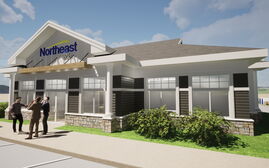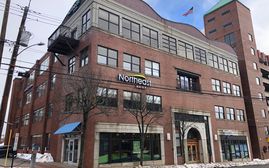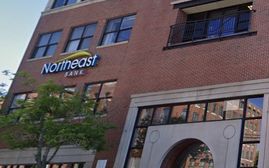Unusual banking model spurs Northeast Bank's growth
The view from the conference room on the fourth floor of Northeast Bank's headquarters in Lewiston extends south as far as Bleachery Hill, once a manufacturing hub in this central Maine city. Immediately adjacent to the large semi-circle window that frames the view are two monitors mounted to a wall. The monitors also have a southerly inclination — toward Boston, where the bank's senior management team is situated.
Video conferencing is the way senior managers connect with the bank's on-the-ground managers in Maine, says CEO Richard Wayne. It's a far cry from how the publicly traded bank, which dates to 1872, was managed prior to December 2010, when a group of investors, led by Wayne, purchased a controlling interest in it.
The unconventional arrangement allows the bank to do two things: nurture its Boston-based loan acquisition division — which reported returns of 16.2% last quarter and 15.8% in fiscal year 2012 — and grow its Maine-based community bank division. The success of one is totally tied to the other, says Wayne. If the community banking division doesn't grow, the loan acquisition division — and its handsome returns — will be stymied.
An unusual model
To understand the connection between the two divisions, it's necessary to pull the curtain back on the loan acquisition process, an operation Wayne has refined through more than 15 years with previous ventures. At its core, the loan acquisition staff looks for opportunities to buy commercial real estate loans at a discount, and then they manage those loans to make a profit.
Wayne, a New Jersey native who came to Boston to attend law school, is an engaging man with a self-deprecating sense of humor. When asked for a simple explanation of the loan acquisition process, he offers this hypothetical scenario:
Take a strip mall worth $1.5 million in 2007 that received a $1 million loan from its local bank at 6% for a 10-year term. Say the local bank was sold to a larger bank. Now the big bank owns the strip mall loan and isn't comfortable carrying it on its balance sheet. It puts the loan out to bid on the secondary market.
In comes Northeast Bank's loan acquisition team, which recognizes the real estate collateral value of the mall has deteriorated, and assesses the value of the loan based on its own metrics; it offers to buy the loan for $800,000. The big bank — eager to get it off its books — agrees.
Now Northeast owns an $800,000 commercial real estate loan, but the strip mall owner is still bound by the original terms of the $1 million loan at 6% interest. Northeast gets $60,000 a year in interest payments per the original loan agreement on an $800,000 investment, or a 7.5% return.
And a portion of the $200,000 difference between what the mall owner owes and what Northeast paid for the loan can be reported as income on Northeast's balance sheet, boosting the return to 9.5%.
In the aggregate, Wayne says the bank picks up another 7%-8% from early pay-offs and other services related to the loans.
The process, which is repeated dozens of times a year by the Boston-based staff of the bank, is driving Northeast's growth. In fiscal 2013, purchased loans yielded 16.0% and originated loans, 9.3%. In total, the loan acquisition division reported yields of 15.2%.
Niche market expertise
Alexander Twerdahl, an associate director with the investment banking firm Sandler O'Neill in New York City, analyzes Northeast Bank. (Sandler O'Neill underwrote Northeast's common stock offering in May 2012 that raised nearly $53 million in capital for general corporate purposes. That allowed the bank to retire its obligations under the federal stimulus bill for banks, through which Northeast borrowed $4.3 million in late 2008.)
Twerdahl attributes the loan acquisition performance to Wayne and his staff's deep expertise in what is a very niche market.
“It is a unique model,” says Twerdahl. “You don't see many banks doing it. I think a lot of banks are scared because without that expertise, there's a lot that can go wrong.”
Wayne hit upon the loan acquisition strategy back in the '90s. A lawyer and CPA, Wayne and partner Nicholas Lazares founded their own law firm, then raised $7.5 million in capital to start a bank, Atlantic Bank & Trust, in Boston in 1988.
But in the fallout from the savings and loan crisis and the recession of the late '80s, banks were failing in large numbers.
“In 1991, 45 banks closed in Massachusetts alone and we were probably one bad loan from being out of business,” says Wayne, who was a director of Atlantic at the time. “From our $7.5 million in capital, we were down to $4 million.” Wayne and Lazares decided to move from directors into bank management “to figure out how to add value to the bank.”
The answer lay in the millions in assets the Federal Deposit Insurance Corp. acquired from troubled banks. The FDIC was willing to sell the assets at a discount and Wayne and his team saw that as their opportunity. Over the next three years, they put their energy into developing a metric to source, underwrite and service discounted loans, developing expertise to assess the health of a loan and its market worth based on legal, financial, market and environmental criteria.
In 1996, they took the bank public and three years later changed its name to Capital Crossing. By 2007, it had $1.2 billion in assets. The success of Capital Crossing captured the attention of Lehman Brothers, which in 2007 bought the company for $210 million.
“They paid $30 a share, and when we took [Capital Crossing] public in 1996, shares were selling for $3.37,” says Wayne, smiling. “So that was nice.”
Wayne and Lazares were brought on as managing directors at Lehman Brothers, but in less than a year, Lehman realigned management and they resigned.
“It's an old story,” says Wayne with a laugh. “At the time, Lehman Brothers thought they couldn't live without us and then 10 months later, they realized they couldn't live with us.”
Changing course
Wayne says following his departure from Lehman Brothers, he considered returning to school or elevating his photography hobby into a career.
“But my wife pointed out that I'm not a very good photographer, so I decided to go back into banking,” he quips.
By 2009, he and a small group of investors began looking for a bank to buy or gain a controlling interest in. Among the criteria: the bank had to be near Boston, have a healthy balance sheet, a good network of branches, managers Wayne and his colleagues could work with and a willingness to sell at a fair price.
In July, he approached James Delamater, Northeast's former CEO who had been positioning the bank as a one-stop shop for a consumer's financial needs. Throughout the early 2000s, Northeast had acquired more than 10 insurance agencies and launched an investment division. Delamater's goal was to meet customers' needs by creating a centralized finance center, and to diversify the bank's revenue stream. But the strategy never generated the returns the bank's board had hoped for, and it continued to report lackluster returns on assets and stagnant stock prices while competition and regulatory controls increased.
“Northeast was one of the first banks we saw … and [the investor group] ultimately struck a deal with Jim and the board to acquire 60% of the stock,” says Wayne. “We left in place the existing management team and brought in a new senior management team with the idea that we wanted to keep the strong community bank where there's lots of value but add a loan acquisition group to it.”
Since acquiring a controlling interest in Northeast with an almost $30 million capital infusion, Wayne has sold off the insurance division and the investment group is leaving the bank in November to form its own independent company.
“We're trying to do fewer things better,” says Wayne, noting the insurance division had a lot of capital — somewhere around $8.4 million — tied up in it and was only making about $200,000 a year. The investment division didn't have the same capital conditions, but Wayne says it wasn't core to the bank's new direction.
So far, the new focus seems to be paying off. Twerdahl says Wayne's management has been solid.
“He's in the showing-what-he-can-do phase,” says Twerdahl. “People are getting interested.”
A report by Barron's in September 2012 predicted Northeast stock (NBN), then trading on NASDAQ at just over $8 per share, could grow by 25% over the next year based on the loan acquisition division's performance. As of press time, Northeast stock was trading at $10.27 per share.
Essential to growth
What is core to the bank's future is increasing deposits and loans. Federal and state regulators have imposed a requirement that purchased loans — the fodder for the bank's loan acquisition division — can't exceed 40% of Northeast's total loan portfolio. That puts pressure on the bank to increase deposits and originate loans.
Wayne's goal is to get the bank to $1.2 billion in assets. To get there, he cites the potential within the bank's balance sheet, noting it has $122 million in capital but only $671 million in assets.
“Let's say we're at 75% loans-to-assets, [if the bank reaches its $1.2 billion asset goal] we'd have a $900 million loan book, of which $360 million is purchased loans and $540 million would be originated,” he says. “Where we sit today, we're around $180 million of purchased loans. We can roughly double that and we can roughly double the $270 million in originated loans” without substantial increases in its operating expenses.
It has already ramped up its residential lending. At the time of Wayne's arrival in late 2010, the bank was originating approximately $90 million in residential lending. As of June 30, 2013, residential lending was about $140 million.
The emphasis on originating loans, says Wayne, is part of the reason Northeast announced earlier this month a commitment to triple the size of its previous commercial lending to $10 million, aided by an expanded affiliation with the U.S. Small Business Administration.
But Wayne acknowledges there's a lot of competition out there to lend money to Maine's businesses, an observation analyst Twerdahl shares.
“Maine's recovery has been sleepy — there's not a lot of companies looking for new loans and the competition among banks to make those loans is fierce,” he says. “And you never know what the regulators are going to do to change the landscape even further.”
Wayne says Northeast plans to be aggressive in the commercial lending market, but that's not the only strategy. Because it expects to earn higher returns from its loan portfolio than its competitors, it can afford to offer higher interest rates on deposits. The bank is also in the midst of a technology upgrade that will improve its customer service in mobile banking to allow for remote deposits, scanning and other transactions.
Says Wayne, “We have every incentive in the world to continue growing this franchise in Maine.”

















Comments